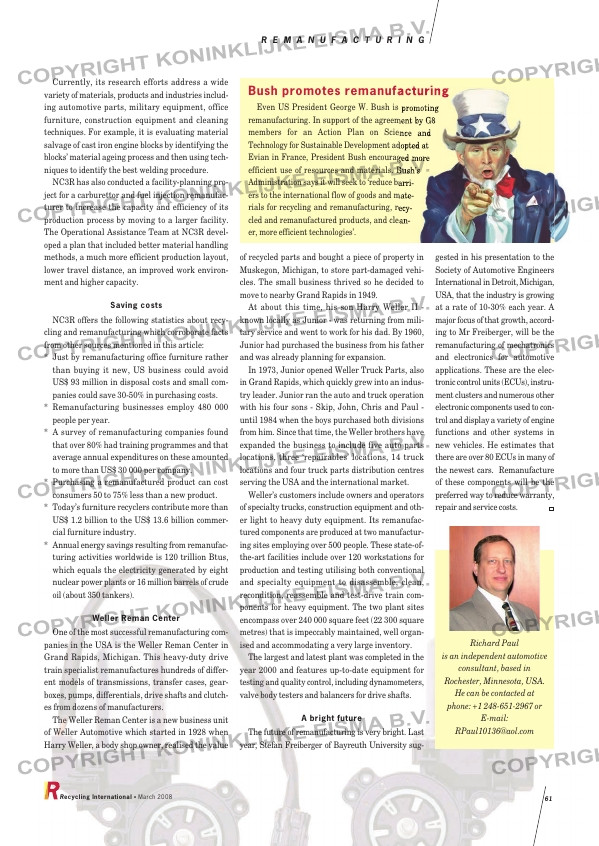Page 61 from: March 2008

Currently, its research efforts address a wide
variety of materials, products and industries includ-
ing automotive parts, military equipment, office
furniture, construction equipment and cleaning
techniques. For example, it is evaluating material
salvage of cast iron engine blocks by identifying the
blocks’ material ageing process and then using tech-
niques to identify the best welding procedure.
NC3R has also conducted a facility-planning pro-
ject for a carburettor and fuel injection remanufac-
turer to increase the capacity and efficiency of its
production process by moving to a larger facility.
The Operational Assistance Team at NC3R devel-
oped a plan that included better material handling
methods, a much more efficient production layout,
lower travel distance, an improved work environ-
ment and higher capacity.
Saving costs
NC3R offers the following statistics about recy-
cling and remanufacturing which corroborate facts
from other sources mentioned in this article:
* Just by remanufacturing office furniture rather
than buying it new, US business could avoid
US$ 93 million in disposal costs and small com-
panies could save 30-50% in purchasing costs.
* Remanufacturing businesses employ 480 000
people per year.
* A survey of remanufacturing companies found
that over 80% had training programmes and that
average annual expenditures on these amounted
to more than US$ 30 000 per company.
* Purchasing a remanufactured product can cost
consumers 50 to 75% less than a new product.
* Today’s furniture recyclers contribute more than
US$ 1.2 billion to the US$ 13.6 billion commer-
cial furniture industry.
* Annual energy savings resulting from remanufac-
turing activities worldwide is 120 trillion Btus,
which equals the electricity generated by eight
nuclear power plants or 16 million barrels of crude
oil (about 350 tankers).
Weller Reman Center
One of the most successful remanufacturing com-
panies in the USA is the Weller Reman Center in
Grand Rapids, Michigan. This heavy-duty drive
train specialist remanufactures hundreds of differ-
ent models of transmissions, transfer cases, gear-
boxes, pumps, differentials, drive shafts and clutch-
es from dozens of manufacturers.
The Weller Reman Center is a new business unit
of Weller Automotive which started in 1928 when
Harry Weller, a body shop owner, realised the value
Recycling International • March 2008 61
R E M A N U F A C T U R I N G
Richard Paul
is an independent automotive
consultant, based in
Rochester, Minnesota, USA.
He can be contacted at
phone: +1 248-651-2967 or
E-mail:
[email protected]
of recycled parts and bought a piece of property in
Muskegon, Michigan, to store part-damaged vehi-
cles. The small business thrived so he decided to
move to nearby Grand Rapids in 1949.
At about this time, his son Harry Weller II –
known locally as Junior – was returning from mili-
tary service and went to work for his dad. By 1960,
Junior had purchased the business from his father
and was already planning for expansion.
In 1973, Junior opened Weller Truck Parts, also
in Grand Rapids, which quickly grew into an indus-
try leader. Junior ran the auto and truck operation
with his four sons – Skip, John, Chris and Paul –
until 1984 when the boys purchased both divisions
from him. Since that time, the Weller brothers have
expanded the business to include five auto parts
locations, three ‘repairables’ locations, 14 truck
locations and four truck parts distribution centres
serving the USA and the international market.
Weller’s customers include owners and operators
of specialty trucks, construction equipment and oth-
er light to heavy duty equipment. Its remanufac-
tured components are produced at two manufactur-
ing sites employing over 500 people. These state-of-
the-art facilities include over 120 workstations for
production and testing utilising both conventional
and specialty equipment to disassemble, clean,
recondition, reassemble and test-drive train com-
ponents for heavy equipment. The two plant sites
encompass over 240 000 square feet (22 300 square
metres) that is impeccably maintained, well organ-
ised and accommodating a very large inventory.
The largest and latest plant was completed in the
year 2000 and features up-to-date equipment for
testing and quality control, including dynamometers,
valve body testers and balancers for drive shafts.
A bright future
The future of remanufacturing is very bright. Last
year, Stefan Freiberger of Bayreuth University sug-
Bush promotes remanufacturing
Even US President George W. Bush is promoting
remanufacturing. In support of the agreement by G8
members for an Action Plan on Science and
Technology for Sustainable Development adopted at
Evian in France, President Bush encouraged more
efficient use of resources and materials. Bush’s
Administration says it will seek to ‘reduce barri-
ers to the international flow of goods and mate-
rials for recycling and remanufacturing, recy-
cled and remanufactured products, and clean-
er, more efficient technologies’.
gested in his presentation to the
Society of Automotive Engineers
International in Detroit, Michigan,
USA, that the industry is growing
at a rate of 10-30% each year. A
major focus of that growth, accord-
ing to Mr Freiberger, will be the
remanufacturing of mechatronics
and electronics for automotive
applications. These are the elec-
tronic control units (ECUs), instru-
ment clusters and numerous other
electronic components used to con-
trol and display a variety of engine
functions and other systems in
new vehicles. He estimates that
there are over 80 ECUs in many of
the newest cars. Remanufacture
of these components will be the
preferred way to reduce warranty,
repair and service costs.
RI_020 Remanufacturing:Opmaak 1 28-02-2008 11:46 Pagina 61



